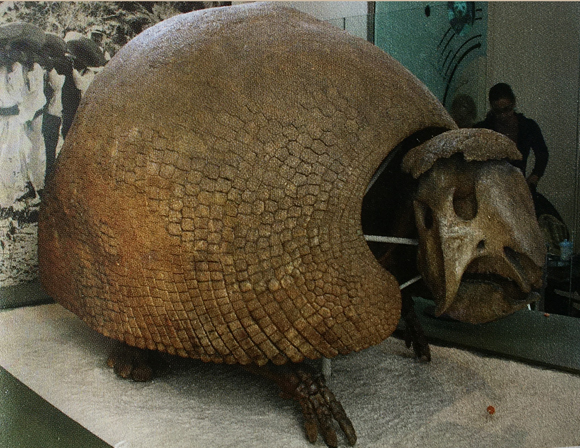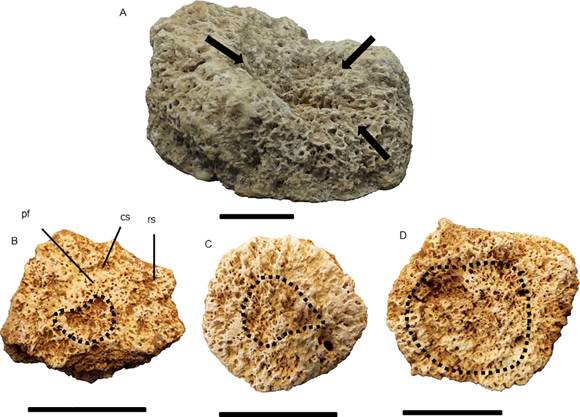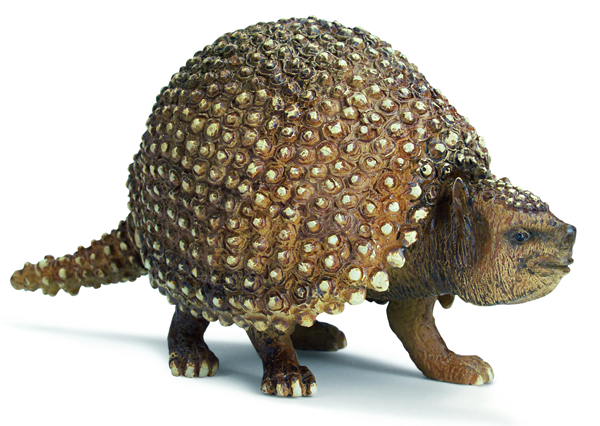Flea Bites and Dermal Infections in Glyptodonts
Fleas on Glyptodonts
A new study examining one of the more bizarre types of megafauna from prehistoric South America has revealed that glyptodonts and their relatives suffered from fleas and dermal infections. It seems that the hard, bony armour of some of these car-sized giants was no defence against flea bites. Brazilian-based scientists writing in the open access, on-line journal “PLOS One”, have studied hundreds of pieces of glyptodont armour and discovered evidence of infections caused by fleas.
Such armour might have deterred a sabre-toothed cat from attacking, but the osteoderms and armoured tails were no defence against parasites.
A Skeleton of the Giant Glyptodont Panochthus spp.

Picture credit: R. Somma/Wikimedia Commons
Extinct Members of the Order Cingulata Studied
The scientists from Universidade Federal Rural do Semi-Árido, Mossoró (Brazil), studied the osteoderms that make up the exoskeleton of two extinct genera of glyptodonts Panochthus (pictured above) and Glyptotherium. In addition, the research team examined the fossilised armour of another extinct armadillo-like creature Pachyarmatherium.
All these mammals belong to the Order Cingulata (armadillos and their relatives). Damaged osteoderms were noted in all three genera and attributed to attacks by fleas and infections. The scientists were able to identify the flea bites as coming from one particular genus – Tunga. The Tunga flea, sometimes referred to as the “jigger flea”, is native to South and Central America and is known to parasitise a number of large mammals including humans. The bites cause well-defined circular lesions and perforations. Such patterning was identified in a number of fossilised pieces of dermal armour.
Flea bites permitted secondary damage to be caused by the invasion of pathogenic microorganisms such as bacteria and fungi.
The External Surface of Osteoderms from the Glyptodont Glyptotherium Showing Pitting and Damage
Picture credit: PLOS One
The picture (above) shows severe pitting (black arrows) in (A) and three other osteoderms attributed to Glyptotherium which show stages of damage from (B), slight, through to (D) advanced pitting and the response to the damage by the deposition of more bone (calcium deposition). The scale bar in A = 3 cm, whereas, the scale bar in B-D is 4 cm.
A Life Reconstruction of a Glyptodont
The bone alteration and re-growth identified in this study represent the first record of flea attack and pitting in two genera of large glyptodonts Panochthus and Glyptotherium and in a non-glyptodontid, large cingulate (Pachyarmatherium), from the Quaternary of the Brazilian Intertropical Region. These newly identified flea bite occurrences and subsequent infections widen the geographic distribution of those diseases during the Cenozoic and provide more evidence for the co-evolution of parasites such as the Tunga flea and South American megafauna.
The scientific paper: “Ectoparasitism and Infections in the Exoskeleton of Large Fossil Cingulates” by Fábio Cunha Guimarães de Lima, Kleberson de Oliveira Porpino published in PLOS One.
Visit the Everything Dinosaur: Everything Dinosaur.



